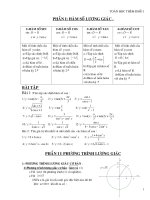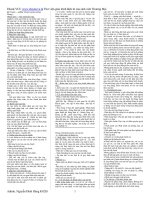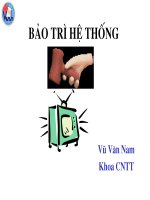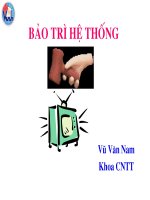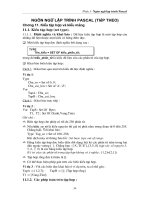- Trang chủ >>
- Mầm non - Tiểu học >>
- Lớp 2
Giáo trình dạy toán cho bé eye on math picture for grade k2
Bạn đang xem bản rút gọn của tài liệu. Xem và tải ngay bản đầy đủ của tài liệu tại đây (4.02 MB, 37 trang )
Eyes on Math
Pictures for
Grades K–2
CCSS
Counting Up by 1s . . . . . . . . . . . . . . . . . . . . . . . . . . . . . . . . . . . . . . . . . . . . . . . . . .K.CC . . . . . . . . . . . . .
Counting Back by 1s . . . . . . . . . . . . . . . . . . . . . . . . . . . . . . . . . . . . . . . . . . . . . . . .1.OA . . . . . . . . . . . . .
Counting Up by 2s . . . . . . . . . . . . . . . . . . . . . . . . . . . . . . . . . . . . . . . . . . . . . . . . . .1.OA . . . . . . . . . . . . .
Counting Back by 2s . . . . . . . . . . . . . . . . . . . . . . . . . . . . . . . . . . . . . . . . . . . . . . . .1.OA . . . . . . . . . . . . .
Counting Up by 5s . . . . . . . . . . . . . . . . . . . . . . . . . . . . . . . . . . . . . . . . . . . . . . . . . .2.NBT . . . . . . . . . . . .
Counting Back by 5s . . . . . . . . . . . . . . . . . . . . . . . . . . . . . . . . . . . . . . . . . . . . . . . .2.NBT . . . . . . . . . . . .
Counting Up by 10s . . . . . . . . . . . . . . . . . . . . . . . . . . . . . . . . . . . . . . . . . . . . . . . . .2.NBT . . . . . . . . . . . .
Counting Back by 10s . . . . . . . . . . . . . . . . . . . . . . . . . . . . . . . . . . . . . . . . . . . . . . .2.NBT . . . . . . . . . . . .
Comparing Numbers by Matching . . . . . . . . . . . . . . . . . . . . . . . . . . . . . . . . . .K.CC . . . . . . . . . . . . .
Benchmark Numbers: All About 5 . . . . . . . . . . . . . . . . . . . . . . . . . . . . . . . . . .K.CC . . . . . . . . . . . . .
Benchmark Numbers: All About 10 . . . . . . . . . . . . . . . . . . . . . . . . . . . . . . . . .K.CC . . . . . . . . . . . . .
Ordinal Numbers . . . . . . . . . . . . . . . . . . . . . . . . . . . . . . . . . . . . . . . . . . . . . . . . . . .K.CC . . . . . . . . . . . . .
Addition as Combining . . . . . . . . . . . . . . . . . . . . . . . . . . . . . . . . . . . . . . . . . . . . .K.OA . . . . . . . . . . . . .
Addition to Describe Part-Part-Whole Situations . . . . . . . . . . . . . . . . . . . .1.OA . . . . . . . . . . . . .
Adding 0 and Adding 1. . . . . . . . . . . . . . . . . . . . . . . . . . . . . . . . . . . . . . . . . . . . . .1.OA . . . . . . . . . . . . .
Addition: Commutativity . . . . . . . . . . . . . . . . . . . . . . . . . . . . . . . . . . . . . . . . . . .1.OA . . . . . . . . . . . . .
Addition: Changing Addends, But Not the Sum . . . . . . . . . . . . . . . . . . . . .1.OA . . . . . . . . . . . . .
Adding or Subtracting 10 . . . . . . . . . . . . . . . . . . . . . . . . . . . . . . . . . . . . . . . . . . .1.NBT . . . . . . . . . . . .
Subtraction as Taking Away . . . . . . . . . . . . . . . . . . . . . . . . . . . . . . . . . . . . . . . . .K.OA . . . . . . . . . . . . .
Subtraction to Compare . . . . . . . . . . . . . . . . . . . . . . . . . . . . . . . . . . . . . . . . . . . .1.OA . . . . . . . . . . . . .
Relating Addition and Subtraction . . . . . . . . . . . . . . . . . . . . . . . . . . . . . . . . . .1.OA . . . . . . . . . . . . .
Naming Two-Digit Numbers . . . . . . . . . . . . . . . . . . . . . . . . . . . . . . . . . . . . . . . .1.NBT . . . . . . . . . . . .
Naming Three-Digit Numbers . . . . . . . . . . . . . . . . . . . . . . . . . . . . . . . . . . . . . . .2.NBT . . . . . . . . . . . .
Place Value: Grouping in Tens . . . . . . . . . . . . . . . . . . . . . . . . . . . . . . . . . . . . . .2.NBT . . . . . . . . . . . .
Place Value: Positions . . . . . . . . . . . . . . . . . . . . . . . . . . . . . . . . . . . . . . . . . . . . . . .2.NBT . . . . . . . . . . . .
Comparing Sizes of Numbers . . . . . . . . . . . . . . . . . . . . . . . . . . . . . . . . . . . . . . . .2.NBT . . . . . . . . . . . .
Fractions: Halves . . . . . . . . . . . . . . . . . . . . . . . . . . . . . . . . . . . . . . . . . . . . . . . . . . .2.G . . . . . . . . . . . . . . .
Fractions: Quarters . . . . . . . . . . . . . . . . . . . . . . . . . . . . . . . . . . . . . . . . . . . . . . . . .2.G . . . . . . . . . . . . . . .
Measurement: Meaning of Length . . . . . . . . . . . . . . . . . . . . . . . . . . . . . . . . . .K.MD . . . . . . . . . . . .
Measurement: Effect of Unit Size . . . . . . . . . . . . . . . . . . . . . . . . . . . . . . . . . . .2.MD . . . . . . . . . . . . .
Measurement: Standard Units of Length . . . . . . . . . . . . . . . . . . . . . . . . . . . .2.MD . . . . . . . . . . . . .
2-D Shapes Versus 3-D Shapes . . . . . . . . . . . . . . . . . . . . . . . . . . . . . . . . . . . . . .K.G . . . . . . . . . . . . . . .
Comparing 2-D Shapes . . . . . . . . . . . . . . . . . . . . . . . . . . . . . . . . . . . . . . . . . . . . . .K.G . . . . . . . . . . . . . . .
Comparing 3-D Shapes . . . . . . . . . . . . . . . . . . . . . . . . . . . . . . . . . . . . . . . . . . . . . .K.G . . . . . . . . . . . . . . .
Composing Shapes . . . . . . . . . . . . . . . . . . . . . . . . . . . . . . . . . . . . . . . . . . . . . . . . . .K.G . . . . . . . . . . . . . . .
Shape Puzzles . . . . . . . . . . . . . . . . . . . . . . . . . . . . . . . . . . . . . . . . . . . . . . . . . . . . . . .K.G . . . . . . . . . . . . . . .
Book
pages
page
6–7 . . . . . . . . . . . 2
8–9 . . . . . . . . . . . 3
10–11 . . . . . . . . . . 4
12–13 . . . . . . . . . . 5
14–15 . . . . . . . . . . 6
16–17 . . . . . . . . . . 7
18–19 . . . . . . . . . . 8
20–21 . . . . . . . . . . 9
22–23 . . . . . . . . . . 10
24–25 . . . . . . . . . . 11
26–27 . . . . . . . . . . 12
28–29 . . . . . . . . . . 13
30–31 . . . . . . . . . . 14
32–33 . . . . . . . . . . 15
34–35 . . . . . . . . . . 16
36–37 . . . . . . . . . . 17
38–39 . . . . . . . . . . 18
40–41 . . . . . . . . . . 19
42–43 . . . . . . . . . . 20
44–45 . . . . . . . . . . 21
46–47 . . . . . . . . . . 22
48–49 . . . . . . . . . . 23
50–51 . . . . . . . . . . 24
52–53 . . . . . . . . . . 25
54–55 . . . . . . . . . . 26
56–57 . . . . . . . . . . 27
58–59 . . . . . . . . . . 28
60–61 . . . . . . . . . . 29
62–63 . . . . . . . . . . 30
64–65 . . . . . . . . . . 31
66–67 . . . . . . . . . . 32
68–69 . . . . . . . . . . 33
70–71 . . . . . . . . . . 34
72–73 . . . . . . . . . . 35
74–75 . . . . . . . . . . 36
76–77 . . . . . . . . . . 37
From Eyes on Math: A Visual Approach to Teaching Math Concepts by Marian Small; illustrations by Amy Lin.
© 2013 by Teachers College, Columbia University. For more information or to order, visit: />
Which ants did Meghan already count?
How high will she go to count
all of the ants?
COUNTING UP BY 1s • Grades K–2 • CCSS K.CC
From Eyes on Math: A Visual Approach to Teaching Math Concepts by Marian Small; illustrations by Amy Lin.
© 2013 by Teachers College, Columbia University. For more information or to order, visit: />
What numbers will be said next?
What does each of the numbers tell?
COUNTING BACK BY 1s • Grades K–2 • CCSS 1.OA
From Eyes on Math: A Visual Approach to Teaching Math Concepts by Marian Small; illustrations by Amy Lin.
© 2013 by Teachers College, Columbia University. For more information or to order, visit: />
What is the best way to count
the bicycle wheels?
COUNTING UP BY 2s • Grades K–2 • CCSS 1.OA
From Eyes on Math: A Visual Approach to Teaching Math Concepts by Marian Small; illustrations by Amy Lin.
© 2013 by Teachers College, Columbia University. For more information or to order, visit: />
Mom is counting how many eggs are left
each time she takes some out.
What numbers will she say if she
takes out 2 eggs at a time?
COUNTING BACK BY 2s • Grades K–2 • CCSS 1.OA
From Eyes on Math: A Visual Approach to Teaching Math Concepts by Marian Small; illustrations by Amy Lin.
© 2013 by Teachers College, Columbia University. For more information or to order, visit: />
Count to know how much money
Keesha has.
COUNTING UP BY 5s • Grades K–2 • CCSS 2.NBT
From Eyes on Math: A Visual Approach to Teaching Math Concepts by Marian Small; illustrations by Amy Lin.
© 2013 by Teachers College, Columbia University. For more information or to order, visit: />
Andrew is buying candies.
How much money will he have left
after he buys each candy?
COUNTING BACK BY 5s • Grades K–2 • CCSS 2.NBT
From Eyes on Math: A Visual Approach to Teaching Math Concepts by Marian Small; illustrations by Amy Lin.
© 2013 by Teachers College, Columbia University. For more information or to order, visit: />
Count the number of fingers,
one set of handprints at a time.
COUNTING UP BY 10s • Grades K–2 • CCSS 2.NBT
From Eyes on Math: A Visual Approach to Teaching Math Concepts by Marian Small; illustrations by Amy Lin.
© 2013 by Teachers College, Columbia University. For more information or to order, visit: />
There are 100 pencils. You put the pencils
from one row at a time into the box.
Count to tell how many pencils are left
outside of the box each time that
one row of pencils is removed.
COUNTING BACK BY 10s • Grades K–2 • CCSS 2.NBT
From Eyes on Math: A Visual Approach to Teaching Math Concepts by Marian Small; illustrations by Amy Lin.
© 2013 by Teachers College, Columbia University. For more information or to order, visit: />
The buttons at the top are arranged
into two lines in two different ways.
Which way makes it easier to tell
which line has more buttons?
!
COMPARING NUMBERS BY MATCHING • Grades K–2 • CCSS K.CC
From Eyes on Math: A Visual Approach to Teaching Math Concepts by Marian Small; illustrations by Amy Lin.
© 2013 by Teachers College, Columbia University. For more information or to order, visit: />
What does each picture tell you
about 5?
FIVE
0
1
2
3
4
5
BENCHMARK NUMBERS: ALL ABOUT 5 • Grades K–2 • CCSS K.CC
From Eyes on Math: A Visual Approach to Teaching Math Concepts by Marian Small; illustrations by Amy Lin.
© 2013 by Teachers College, Columbia University. For more information or to order, visit: />
What do all of the pictures
have in common?
BENCHMARK NUMBERS: ALL ABOUT 10 • Grades K–2 • CCSS K.CC
From Eyes on Math: A Visual Approach to Teaching Math Concepts by Marian Small; illustrations by Amy Lin.
© 2013 by Teachers College, Columbia University. For more information or to order, visit: />
Which elephant is fourth?
ORDINAL NUMBERS • Grades K–2 • CCSS K.CC
From Eyes on Math: A Visual Approach to Teaching Math Concepts by Marian Small; illustrations by Amy Lin.
© 2013 by Teachers College, Columbia University. For more information or to order, visit: />
What different addition sentences
might tell how many books will be
on each shelf after putting away
the books on the floor?
ADDITION AS COMBINING • Grades K–2 • CCSS K.OA
From Eyes on Math: A Visual Approach to Teaching Math Concepts by Marian Small; illustrations by Amy Lin.
© 2013 by Teachers College, Columbia University. For more information or to order, visit: />
What does each picture show
about addition?
ADDITION TO DESCRIBE PART-PART-WHOLE SITUATIONS • Grades K–2 • CCSS 1.OA
From Eyes on Math: A Visual Approach to Teaching Math Concepts by Marian Small; illustrations by Amy Lin.
© 2013 by Teachers College, Columbia University. For more information or to order, visit: />
The kangaroos started at 3 and 5.
The picture shows where they landed
after one jump.
What number sentences tell about
each kangaroo’s jump?
START
END
START END
ADDING 0 AND ADDING 1 • Grades K–2 • CCSS 1.OA
From Eyes on Math: A Visual Approach to Teaching Math Concepts by Marian Small; illustrations by Amy Lin.
© 2013 by Teachers College, Columbia University. For more information or to order, visit: />
Why might Amy and Aaron write
different number sentences to tell
what the dice roll is?
ADDITION: COMMUTATIVITY • Grades K–2 • CCSS 1.OA
From Eyes on Math: A Visual Approach to Teaching Math Concepts by Marian Small; illustrations by Amy Lin.
© 2013 by Teachers College, Columbia University. For more information or to order, visit: />
How are the number sentences
you write to tell about all of the frogs
the same and different after
the two frogs move over?
ADDITION: CHANGING ADDENDS, BUT NOT THE SUM • Grades K–2 • CCSS 1.OA
From Eyes on Math: A Visual Approach to Teaching Math Concepts by Marian Small; illustrations by Amy Lin.
© 2013 by Teachers College, Columbia University. For more information or to order, visit: />
When you include or take away
an extra 10 fingers,
what about the total number of fingers
does not change? Why?
ADDING OR SUBTRACTING 10 • Grades K–2 • CCSS 1.NBT
From Eyes on Math: A Visual Approach to Teaching Math Concepts by Marian Small; illustrations by Amy Lin.
© 2013 by Teachers College, Columbia University. For more information or to order, visit: />
Decide how many cookies are
probably on the plate.
What number sentence would you use
to describe what happened when
Caelan took his cookies?
SUBTRACTION AS TAKING AWAY • Grades K–2 • CCSS K.OA
From Eyes on Math: A Visual Approach to Teaching Math Concepts by Marian Small; illustrations by Amy Lin.
© 2013 by Teachers College, Columbia University. For more information or to order, visit: />
What does 12 – 8 tell you
about the insects?
SUBTRACTION TO COMPARE • Grades K–2 • CCSS 1.OA
From Eyes on Math: A Visual Approach to Teaching Math Concepts by Marian Small; illustrations by Amy Lin.
© 2013 by Teachers College, Columbia University. For more information or to order, visit: />
Does this picture show
addition or subtraction or both?
RELATING ADDITION AND SUBTRACTION • Grades K–2 • CCSS 1.OA
From Eyes on Math: A Visual Approach to Teaching Math Concepts by Marian Small; illustrations by Amy Lin.
© 2013 by Teachers College, Columbia University. For more information or to order, visit: />
Which section has 32 cubes?
How do you know?
NAMING TWO-DIGIT NUMBERS • Grades K–2 • CCSS 1.NBT
From Eyes on Math: A Visual Approach to Teaching Math Concepts by Marian Small; illustrations by Amy Lin.
© 2013 by Teachers College, Columbia University. For more information or to order, visit: />
When you write the numbers for
each section, how are the numbers alike
and how are they different?
NAMING THREE-DIGIT NUMBERS • Grades K–2 • CCSS 2.NBT
From Eyes on Math: A Visual Approach to Teaching Math Concepts by Marian Small; illustrations by Amy Lin.
© 2013 by Teachers College, Columbia University. For more information or to order, visit: />
How does the arrangement of stars
help make it easier to count them?
PLACE VALUE: GROUPING IN TENS • Grades K–2 • CCSS 2.NBT
From Eyes on Math: A Visual Approach to Teaching Math Concepts by Marian Small; illustrations by Amy Lin.
© 2013 by Teachers College, Columbia University. For more information or to order, visit: />

